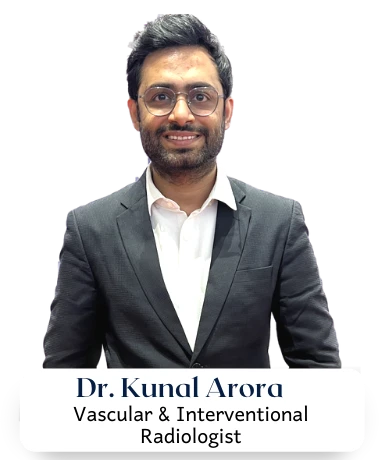Uterine fibroids are the most common benign tumors in females, occurring in 20-40% of women of childbearing age. These tumors, which can vary greatly in size, are often a source of significant discomfort and health issues. While traditional surgical treatments such as myomectomy and hysterectomy are options, non-surgical treatments like Uterine Artery Embolization (UAE) offer a less invasive, highly effective alternative. Dr. Kunal Arora, an esteemed interventional radiologist, shares valuable insights on non surgical treatment for uterine fibroids in Mumbai.
What are Uterine Fibroids?
Uterine fibroids are non-cancerous growths that develop in the muscular wall of the uterus. They can be classified based on their location:
– Intramural Fibroids: Develop within the uterine wall.
– Subserosal Fibroids: Grow just beneath the uterine surface and extend outward.
– Submucosal Fibroids: Grow beneath the uterine lining and can cause heavy bleeding.
Causes and Diagnosis
The exact cause of uterine fibroids is unknown, but several factors may play a role, including genetic predisposition, hormonal imbalances, and lifestyle factors. Fibroids are typically diagnosed through ultrasound, often during routine checkups or when symptoms such as heavy menstrual bleeding or pelvic pain arise. In cases of large fibroids, an MRI may be recommended for a clearer assessment.
Non-Surgical Treatment Options
Uterine Artery Embolization (UAE)
Uterine Artery Embolization is a minimally invasive procedure performed by interventional radiologists like Dr. Kunal Arora. It involves blocking the blood supply to the fibroids, causing them to shrink and die. Here’s an overview of the procedure:
Procedure:
1. Preparation: The patient is sedated and local anesthesia is applied.
2. Catheter Insertion: A tiny incision is made in the groin, and a catheter is inserted into the uterine artery using angiography for guidance.
3. Embolization: Small particles (polyvinyl alcohol) are injected through the catheter to block the blood vessels feeding the fibroids.
4. Recovery: The procedure usually requires a one-night hospital stay, with most patients resuming light activities within a few days.
Benefits of Uterine Artery Embolization
– Effectiveness: UAE treats all fibroids simultaneously, with a success rate of 96-98%.
– Minimally Invasive: Requires only a small incision, resulting in no surgical scars.
– Quick Recovery: Most patients return to normal activities within a week.
– Preserves Uterus: Ideal for women who wish to avoid hysterectomy.
– Low Recurrence Rate: The treated fibroids rarely grow back.
Ideal Candidates for UAE
– Women with symptomatic fibroids.
– Those wishing to retain their uterus.
– Patients who are poor surgical candidates (e.g., due to obesity or anemia).
– Women who do not desire surgery.
FAQs about Uterine Artery Embolization
Can multiple fibroids be treated with UAE?
Yes, UAE can effectively treat multiple fibroids in one procedure.
Will I be able to have a baby after UAE?
Many women have had successful pregnancies post-UAE. However, there are risks, and it’s important to discuss fertility plans with your doctor.
Can UAE be performed at age 50?
Yes, age is not a strict barrier for UAE. The suitability depends on individual health conditions.
Are there any side effects of UAE?
Common side effects include mild pelvic pain and low-grade fever, which are manageable with medication. There is a small risk of infection.
Is UAE a proven technique?
Yes, UAE is a well-established procedure with a high success rate.
Is UAE expensive?
While the cost varies, UAE is generally less expensive than surgical options due to shorter hospital stays and quicker recovery.
Can large fibroids be treated with UAE?
Yes, even large fibroids can be effectively treated with UAE.
Can pedunculated fibroids be treated with UAE?
Pedunculated fibroids, which are attached by a stalk, can be treated with UAE, but it depends on their location and size.
Is UAE suitable for a 10 cm fibroid?
Yes, UAE can effectively treat fibroids of various sizes, including those measuring 10 cm.
Can intramural fibroids be treated with UAE?
Yes, UAE is effective for intramural fibroids.
Why don’t gynecologists always suggest UAE?
Some gynecologists may prefer surgical options due to their familiarity with them, or they may refer patients to interventional radiologists for UAE.
Is UAE recommended for unmarried women?
UAE can be a suitable option for unmarried women, depending on individual circumstances and health goals.
What is the recurrence rate of fibroids after UAE?
The recurrence rate is low, with most treated fibroids not regrowing.
Other Non-Surgical Treatments
High-Intensity Focused Ultrasound (HIFU)
HIFU is another non-invasive treatment that uses focused ultrasound waves to heat and destroy fibroid tissue. It is performed under MRI guidance to precisely target the fibroids.
Medication Options
While medications cannot eliminate fibroids, they can help manage symptoms:
– GnRH Agonists: Reduce estrogen and progesterone levels to shrink fibroids temporarily.
– Androgens: Rarely used due to side effects but can stop menstruation and correct anemia.
Advantages of Non-Surgical Treatments
– No Major Surgery: Minimizes risks associated with surgical procedures.
– Quick Recovery: Shorter downtime compared to surgical options.
– Retention of Uterus: Ideal for women who wish to avoid hysterectomy.
Non-surgical treatments like Uterine Artery Embolization offer a promising alternative for women with uterine fibroids, providing effective relief with minimal invasiveness. Dr. Kunal Arora emphasizes the importance of consulting with an experienced interventional radiologist to explore all available options and choose the best treatment plan.
For more information or to schedule a consultation, contact Dr. Kunal Arora. With advancements in non-surgical treatments, managing uterine fibroids has never been more accessible and effective.


